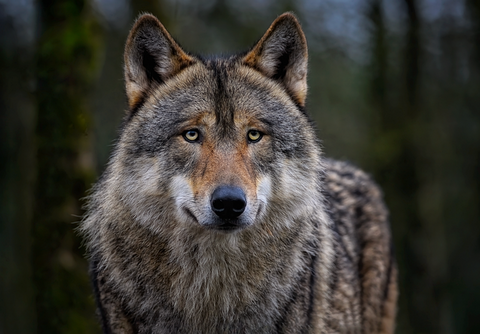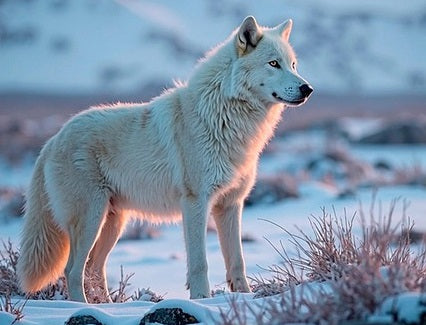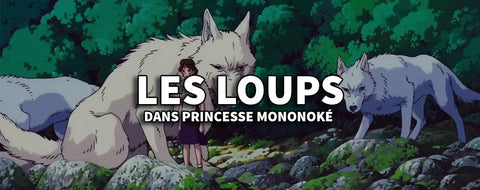
TOP 42 Fun Facts About Wolves
of reading - words
Wolves have often been a source of intrigue for humans. Powerful, intelligent, fascinating, and wild, the wolf has been a source of inspiration for some peoples, and a big bad wolf for others. The bad reputation of wolves has always been based on unfounded facts.
Once upon a time they scared us, but today, discover 42 fun facts about wolves , these cute and organized creatures.
Description of the Wolf
- The gray wolf is known as the timber wolf in North America and the white wolf in the Arctic, and more generally as the common wolf.
- Wolves run on their tiptoes , which helps them stop and turn quickly and prevents wear on their pads.

- Immense power is concentrated in a wolf's jaw. It exerts a crushing pressure of nearly 103 bars (compared to about 51 for a large dog). The jaws themselves are massive, bearing 42 specialized teeth for stabbing, shearing, and crushing bones. Their jaws also open wider than a dog's.
- The gray wolf is the most widespread large land mammal on the planet after humans and livestock.
- Wolves are not particularly fast, with a top speed of around 45 km/h. Instead, they rely on their hearing and smell to detect their prey. They have remarkable endurance and are known to track their target all day and night if necessary.
- Wolves are the largest members of the dog family .
- In 1600, the gray wolf population in North America was 2 million individuals . Today, the population in North America is about 65,000 wolves. The global population is about 150,000.
The Feeding of Wolves
- When they do manage to kill an animal, wolves don't eat in moderation. A single wolf can consume 9 kg of meat in one sitting! The highest-ranking wolf will eat first, and whatever cannot be eaten is left for the scavengers, even if they have to wait three more days for their next meal.
- In Canada, beach wolves swim between islands, eating crabs, clams, and other small items.
- Wolf Fishing : In the British Columbia forest, wolves fish for salmon during the spawning season.
Wolves can go more than a week without eating .
Wolf Species
- Among the true wolves, two species are recognized: Canis lupus (often simply called "gray wolves"), which includes 38 subspecies, such as the gray wolf, timber wolf, arctic wolf, tundra wolf, lobos wolf, and buffalo wolf. The other recognized species is the red wolf ( Canis rufus ), which is smaller, has longer legs, and shorter fur than its relatives. Many scientists debate whether the Canis rufus is a separate species.
- There are many subspecies of wolves, including the Arctic wolf , all of which use a variety of howls to communicate with their fellow wolves.

- Despite their name, gray wolves (Canis lupus) aren't always just gray. These canids can also have black or white fur . Those with black fur are, quite logically, called black wolves.
The Cub and Wolf Reproduction
- For a new wolf cub to urinate, its mother must massage its belly with her warm tongue.
- Once a wolf finds a mate, they usually stay together for life .
- Wolves have only one breeding season a year, in winter. They have their cubs in late April or early May. The cubs are born in an underground hole, or den. A litter typically has four to six cubs . Cubs grow quickly and are almost adult by the end of their first winter. They reach adult size at two years of age.
The Pack
- Wolves develop close relationships and strong social bonds. They often show deep affection for their families and may even sacrifice themselves to protect the family unit.
- A wolf pack consists of two or more wolves that have a defined territory.
- They have a highly organized social structure that allows them to enjoy maximum cooperation when hunting, communicating, and defending their territory.
- Wolves live and hunt in packs. They are known to travel great distances, up to 20 km in a single day. In the far north, wolf packs often travel hundreds of kilometers each year, following migrating herds.

- These social animals cooperate on their preferred prey. A single wolf can catch and kill a deer unaided, but when hunting in a pack, they prey on much larger animals, including deer, elk, and moose. Wolves also feed on small mammals such as birds, fish, lizards, snakes, and fruit.
- The hierarchy that exists within each pack is maintained by dominant or submissive body posture, and by other behaviors such as collective care of the young.
- A wolf that has been driven from the pack or has left on its own is called a lone wolf . It avoids contact with packs and rarely howls.
- Wolf packs are established according to a strict hierarchy, with a dominant alpha male at the top and an alpha female not far behind. Usually, this male and female are the only animals in the pack to reproduce. Packs are composed of five to ten animals, usually several years old. All adults in a pack help care for the young wolf pups by bringing them food and observing them while the others hunt.
The Territory of these Wild Animals
- Wolves are highly territorial animals, typically establishing territories much larger than they need to survive, to ensure a steady supply of prey. Territory size depends largely on the amount of prey available: in areas where prey is abundant, the territories of resident wolf packs are smaller.

- Biologists describe wolf territory as not just spatial, but spatiotemporal , so that each pack moves in and out of each other's territory based on when "no trespassing" signals were posted.
The Wolf and the Man
- Wolves are thought to have been first tamed in East Asia around 15,000 years ago.
- The Cherokee Indians did not hunt wolves because they believed that the brothers of a slain wolf would take revenge. Furthermore, if a weapon were used to kill a wolf, it would no longer function properly.
- Around the year 800, Charlemagne founded a special wolf hunting force, the Louveterie, which remained active until 1789. It was reactivated in 1814, and the last French wolf was killed in 1927.
- The gray wolf has been the notorious villain of fables and fairy tales for centuries, but this highly intelligent and sociable animal has done little to live up to its terrifying reputation.
- The autoimmune disease Systemic Lupus Erythematosus (SLE), or lupus, literally means wolf rash, because in the 18th century, doctors believed the disease was caused by a wolf bite .
- The Vikings wore wolf pelts and drank wolf blood to confront the wolf spirit in battle. They also regarded real wolves as battle companions or hrægifr (corpse trolls).

- Once widespread in North America, Europe and the Far East, the gray wolf is unfortunately now found in large numbers only in certain regions of the USSR, North America and Eastern Europe.
- Wolves are legendary for their spine-tingling howls, which they use to communicate. A lone wolf howls to get the attention of its pack, while collective howls can send territorial messages from one pack to another. Some howls are confrontational. Rival packs may respond to calls. Just like domestic dogs bark, wolves may simply start howling because a neighboring wolf has already started.
- In 1500, the last wolf was killed in England. In 1770, the last wolf in Ireland was killed. In 1772, the last wolf in Denmark was killed.
- The gray wolf has always been feared by humans and has probably been persecuted more than any other animal. Did you know that centuries ago, wolves were "judged" by humans and burned at the stake? However, its intelligence and flexibility saved it from extinction. Phew!
- In the Harry Potter universe, the werewolf Remus Lupin's name is directly related to the Latin word for wolf (lupus) and suggests an association with one of the founders of Rome, Remus, who was suckled by a wolf. The dual nature of Lupin's werewolf suggests that in the Potter kingdom, there are two sides to everything!
- The Wolf Wars: Wolves are back. It's a great time for wildlife lovers. But wolves are still wolves, killing cattle and elk. Many Westerners are angry. Thus, the age-old struggle for land and food has resumed.
- Between 1883 and 1918, more than 80,000 wolves were killed in Montana for bounty.
- Another reason for its decline has been the dramatic reduction in its natural prey. These have been largely replaced by livestock, protected through the use of traps and guns. The wolves' ultimate fate will depend on humans' willingness to coexist with them.
- Stuffed animals are very important for children:
- They awaken and develop his imagination.
- They help develop gentleness, compassion and tenderness in the child so that he or she becomes a super wolf cub!
- Stuffed animals comfort children in difficult times.
- They improve language development.
- And finally, stuffed toys make great gifts!

Now that you know almost everything about wolves and stuffed animals, you can help your little wolf cub become a big wolf (or a big she-wolf)! To do this, thanks to the best animal stuffed animals, your wolf cub will be able to create his imaginary world of animals from the savannah, the forest, elephants, tigers Tiger Stuffed Animals ...or even penguins.
So discover all the stuffed animals from the animal world at the Peluche Kingdom® Plush Boutique and let your child and their imagination reign over their new world!




